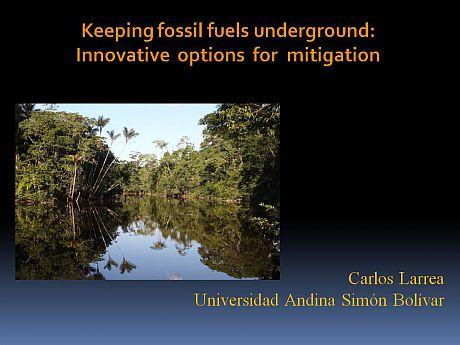Studies have shown that burning fossil fuels is the biggest source of CO2 emissions and thus the major driving force of climate change1–3. Sadly, scholars also critique the fact that current mitigation tools do not currently address the issue adequately.
Emission trading and programs, such as Reducing Emissions of Degradation and Deforestation (REDD), do not tackle the essence of the problem underlying the fossil fuel economy4. Rather than questioning it, it could be argued that carbon trading can be seen to legitimise and stabilize our fossil fuel based economies4.
The mitigation tool provided by the original concept of the Yasuni ITT initiative is fundamentally different. By leaving fossil fuels under the ground at biodiversity hotspots we would take an important step towards a more resilient global future.
According to a study by the International Energy Agency, one third of all fossil fuels must be left un-extracted if we do not want the temperature to increase by more than two degrees by the end of this century5. An analysis of the Gratham Research Institute and Carbon Tracker even states that ‘a precautionary approach means only 20% of total fossil fuel reserves can be burnt to 2050’6. In fact the the institutes confirms that the majority of the remaining fossil fuels are unburnable’6 if we want to maintain a safe human space on our planet7.
What can be achieved by non-extraction of fossil fuels?
An overview of scientific findings and ideas on how to implement non-extraction of fossil fuels at other sites.
The global perspective
Mitigating climate change
The mitigation tool provided by the original concept of the Yasuni ITT initiative is fundamentally different. By leaving fossil fuels under the ground at biodiversity hotspots we would take an important step towards a more resilient global future.
A local impact
Avoiding the resource curse
By avoiding extraction of resources we can also avoid many local problems that often arising as a consequence. The so-called ‘resource curse’ is a well known problem also described as the ‘paradox of plenty’9–11. Resource-rich countries often perform economically worse than countries with fewer resources and they experience disproportionally more civil war. See more
A Global impact
Protecting the living space of current and future generations
Many studies highlight the fact that it is not enough to only consider short term monetary gains when dealing with national development. The planetary boundary model shows us that we have to look for holistic solutions. Failing to preserve our biodiversity and reduce carbon emissions or overconsumption of potable water can lead to irregular and unpredictable changes that can have major implications at teh plaentary level. At the same time we have to think of distributional justice to guarantee a safe human space, not only for a small fraction of the world population, but for the majority, and for future generations.
How can this be achieved?
See more on Yasunisation: Ways of non-extractivism globally
 Presentation by Professor Carlos Larrea, March 2013 University of Sussex
Presentation by Professor Carlos Larrea, March 2013 University of Sussex
References
[1] Espinosa, C. (2013), "The riddle of leaving the oil in the soil. Ecuador's Yasuní-ITT project from a discourse perspective", Forest Policies and Economics, Vol. 36, p. 27–36. Abstract available at: http://www.sciencedirect.com/science/article/pii/S1389934112001633
[3] Larrea, C. (2013), “Ecuadors Yasuni-ITT Initiative A Critical Assessment”.
[5] Viúdez, J. (2013), "La huella empersarial en el clima", El País, 1 December 2013.
[6] Leaton, J. et al (2013), “Unburnable-Carbon-2013. Wasted capital and standed assests”.
[11] Mac Ginty, R. and Williams, A. (2009), "Conflict and development", London, New York: Routledge.
[12] Bebbington, A. et al (2008), "Contention and Ambiguity: Mining and the Possibilities of Development", Development and Change,Vol. 39, No 6, pp. 887–914. Abstract available at: http://onlinelibrary.wiley.com/doi/10.1111/j.1467-7660.2008.00517.x/abstract
[14] Ristau, O. (2014), "Gefährlicher Kohlestaub in Kolumbien", Deutsche Welle, 13.04.2014.
[18] Larrea, C. and Warnars, L. (2009), “Ecuador's Yasuni-ITT Initiative: Avoiding emissions by keeping petroleum underground”, Energy for Sustainable Development, Vol. 13, pp. 219–223. Abstract available at: http://www.sciencedirect.com/science/article/pii/S0973082609000581
[20] Practical Action (2010), "Poor people's energy outlook 2010". Other years are also available at: http://policy.practicalaction.org/policy-themes/energy/poor-peoples-energy-outlook
